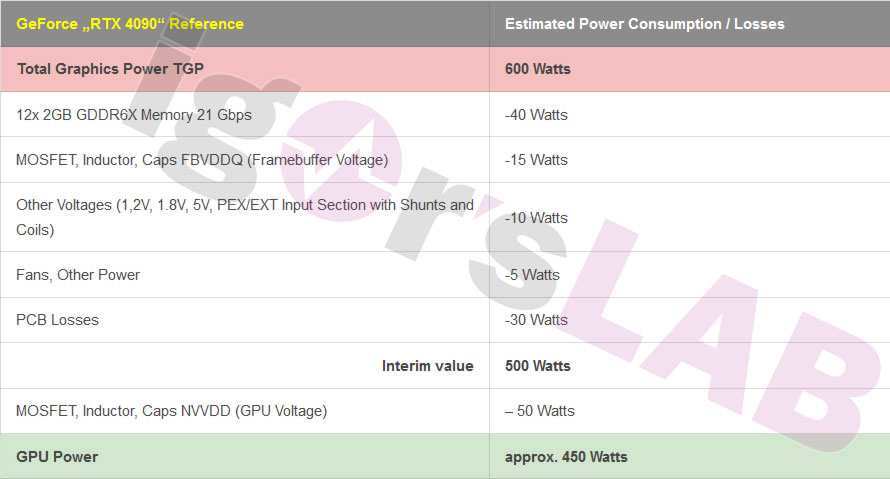Nvidia GeForce RTX 4090 Really Could Pull 600 Watts of Power
Calculations are based on industry sources and component assumptions.
Nvidia's next-generation flagship graphics card is expected to require 450W of power for the GPU alone, and the board as a whole (TGP) will approach 600W. These projections come from Tom's Hardware Germany Alumnus Igor Wallossek, who insists that the same industry insider info and assumptions helped him predict the RTX 3090's power draw "almost exactly right on the watt" ahead of its launch.
Wallossek says Nvidia's GeForce RTX 3090 Ti provides insight into the company's plans for the RTX 4090. Add-in-Board partners (AIBs) have confirmed to Wallossek that the GeForce RTX 3090 Ti PCBs will be similar to the next-gen cards. Still, he warns those starting rumors that they will be "pin-compatible" are indulging in purely wishful thinking, according to his knowledge. Rather, the insight that the RTX 3090 Ti board design provides is mostly about power delivery/consumption.
In his report, the Igor's Lab editor outlines his past GeForce RTX power consumption predictions and applies a similar model to the RTX 4090. We have only reproduced the latter here, but please check out the source if you want to look back at history.
Wallossek says the TGP figure of 600W, which seems to be derived from his insider contacts and the clues found in the RTX 3090 Ti, is like "Ada's Playground."
From the TGP figure of 600W, Wallossek deducts several reasonable subcomponent consumption figures. With Ada Lovelace architecture GPUs like the RTX 4090, the newer GDDR6X from Micron is expected to eat through ~20W less power than the previous gen. Even though they are faster VRAM chips, the quantity required may be cut in half due to their increased density. Other significant deductions made to come to the 450W max GPU consumption come from MOSFETs, fans, PCB losses, and a lot of wasted energy which will be converted to heat.
Though Igor's Lab has a good track record on these topics, please add a sprinkling of salt just in case.
Previous leaks have provided indications that the biggest Ada GPU, probably AD102 and used in a GTX 4090, will offer as many as 18,432 CUDA cores (75% more than the RTX 3090). Both these figures are likely to be somewhat reduced in practice for shipping consumer products due to yields. Ada GPUs may also feature in the first PCIe 5.0 compliant graphics cards.
Unfortunately, the expected GeForce GTX 40-series isn't expected to launch until September. If this timescale is correct, leaks should be pretty intense and get more accurate during the summer. We might also hope for some official Nvidia teasers around Computex time.
Get Tom's Hardware's best news and in-depth reviews, straight to your inbox.
For some, waiting for the GeForce RTX 40-series is a bit too far away, and with GPU prices plummeting there may even be some bargains to be had in the coming months. If you are in the market for a graphics card, you can always start by picking through our GPU benchmarks hierarchy, and checking prices and availability in your region.

Mark Tyson is a news editor at Tom's Hardware. He enjoys covering the full breadth of PC tech; from business and semiconductor design to products approaching the edge of reason.
-
rgd1101 isn't the 450w on the 3090ti is for the card? and this 450w for 4090 is just for the nvidia chipReply -
hotaru.hino Reply
The 450W figure for the 3090 Ti is total board power. This article is suggesting the total board power for the 4090 is 600W with 450W just for the GPU.kiniku said:Clickbait headline. As the 3090ti pulls 450W too. -
sizzling At a time when most companies are being pressured to reduce their products power requirements this would be an ignorant step. I really believe we will see counties introducing power restrictions on home PC’s in the future. For example we already have a 900w limit on vacuum cleaners in the EU, a device that is probably used for less than 1hr week in the average home.Reply -
wifiburger in other news, nothing newReply
my xoc 3090 goes 600w+ if I use 8k, path RTX or no FPS limit in some heavy games
the 3x8pins will go more 700w+
it's good in winter for heating up the entire house floor with the heater at low/off in the house :-) -
hotaru.hino Reply
Yes, but how many house holds will have an RTX 4090?sizzling said:At a time when most companies are being pressured to reduce their products power requirements this would be an ignorant step. I really believe we will see counties introducing power restrictions on home PC’s in the future. For example we already have a 900w limit on vacuum cleaners in the EU, a device that is probably used for less than 1hr week in the average home.
Maybe we should ask sports car manufacturers that their cars can produce no more than 200HP. -
closs.sebastien same as for the cars in France, governments should put bonus-malus payments to products which are too power-hungry.Reply
As we are speaking more and more of green IT.. or green and eco-friendly way of life...
nvidia (and intel by the way) is going against the current.
In computer world, till these last years, the progress was : more computing power with smaller components, same or smaller price, and less energy.
since 5-8 years, this is finished...
Where is the prowess and the proud, when you make a 2x faster component, which is 2x bigger and 3x power-hungry? it is not a progress at all.
One fact is sure for now for me: even if the price can be affordable, I would avoid any components which are too power-hungry.
